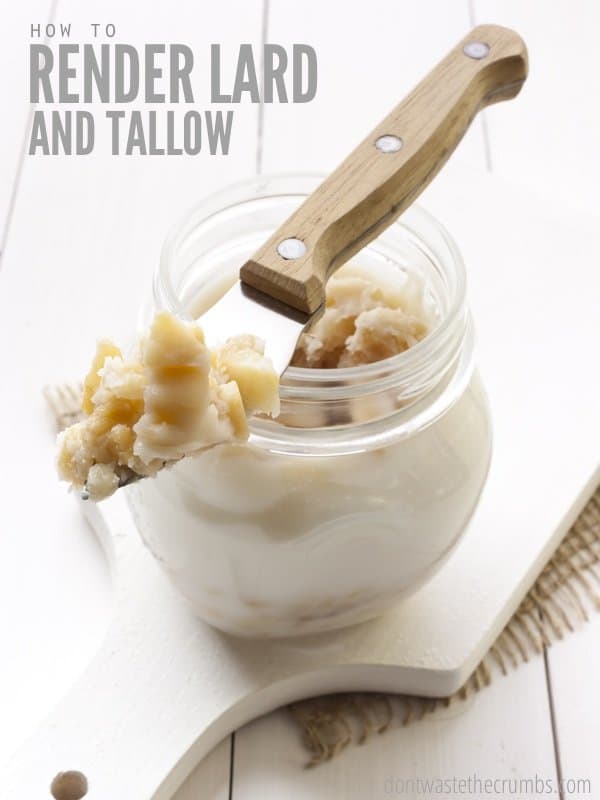
Lard has a bad rap. And most people have no clue what tallow is. I’m included in that “most people” too – I was clueless until earlier this year!
However both lard and tallow are excellent choices of cooking fat. And in case you didn’t know either, lard is pork fat and tallow is beef fat. They have way more nutritional value than the yellow vegetables oils we’ve been groomed to use.
Being able to make them yourself gives them a cool factor too. Kinda like making your own yogurt. Or almond milk.
The technical term for making lard and tallow is “rendering” – it’s the process of taking raw fat and melting it down. It’s super easy to do, and there are several ways to do it.
- In a slow cooker
- In the oven
- On the stove top
There are also two different methods that you can use as well:
- Dry Render: No liquid is added during the rendering process. (Note: requires a more watchful eye.)
- Wet Render: Filtered water is added at the beginning to help prevent the fat from burning.
The end results are the same whichever heating method you choose, and whether or not you use liquid. My slow cooker has been going for two days with homemade chicken stock and I desperately need my counter space back to make yogurt, so I chose the stove top method.
Since the method is the same for both lard and tallow, pick your fat and let’s get cooking!
How To Render Lard or Tallow
Supplies
1-2 lbs pork fat (leaf fat is preferred, runner up is back fat), or Beef Suet
½-1 cup water
heavy stock pot or cast iron skillet
canning funnel (optional, but handy)
fine mesh sieve lined with cheesecloth or a coffee filter
wide-mouth glass jars for storage
Method
Trim excess meat and blood from the fat. (Leaf fat will be mostly white; back fat will have a pinkish tint.)
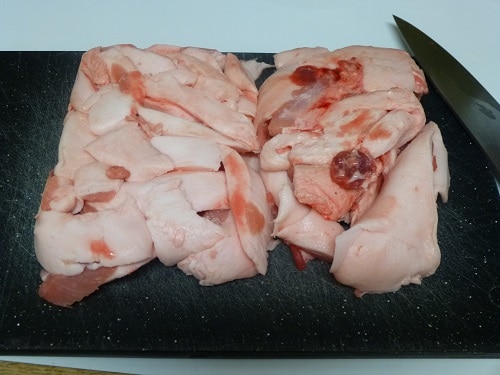
Place the fat and water into the pot and turn the heat on medium low.
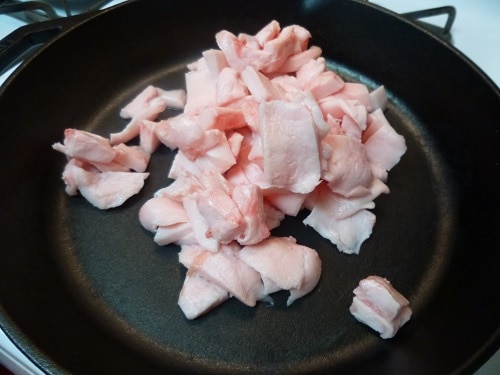
Cook the fat on a solid simmer, stirring often and adjusting heat as necessary. Remember that hot fat will sputter as it cooks in water, so try to keep the heat on the lower end for your own safety.
After 30 minutes or so, the fat will begin to melt. You will see spots where the fat is floating in the water. (My water had seemed to have completely evaporated at this point, a bit too early. So I covered the fat with a clear lid and add more water.)
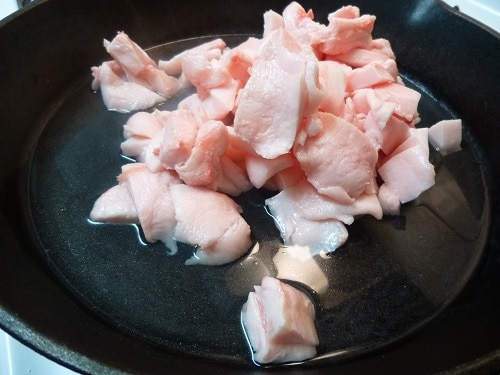
After 45 minutes, the fat will begin to brown and continue to cook down.
When you have anywhere from ½” to 1” of liquid fat, begin to strain some out (see note below). This will help keep the fat cooking and reduce any sputtering you may have. The lid is also helpful for keeping the sputters headed away from you. The fat will have a tint of yellow but should turn white as it cools.
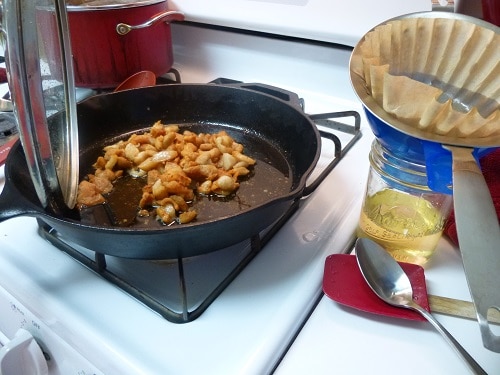
Continue cooking the fat and ladling out the liquid as the fat cooks down.
When the remaining fat becomes dark golden brown, you are done. These solids are called cracklings and can be toasted in the oven before adding to salads or snacking.
Allow the jar of lard to cool to room temperature. Lard can be stored at room temperature for awhile, but the fridge should be used if you’re not sure when you plan to use it next. Lard can be stored in the freezer indefinitely.
My straining contraption
This is my basic set-up for all my straining needs… kefir, yogurt, chicken stock… it’s so easy and all I had to do was add a coffee filter for today!
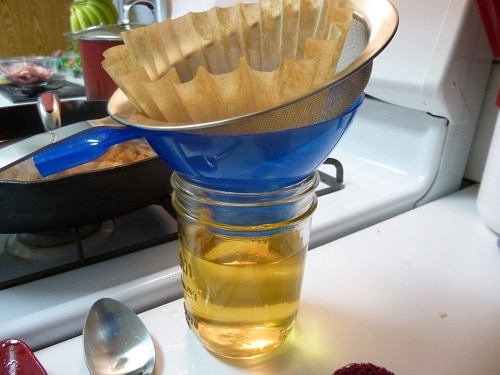
- Use a wide-mouth jar (the jar in the picture is a pint, but I use quart-sized for yogurt and broth).
- Place a canning funnel in the jar (I use the one from this kit).
- Lay a fine mesh sieve inside the funnel.
- Line the sieve with a coffee filter.
Other Helpful Hints and Observations
- I started the project with just over one pound of fat (1lb and 3oz, to be exact) and I now have just over ¾ of a pint jar of lard, or 12oz or so.
- The whole process took about one hour. I imagine it going a bit faster the next time though now that I know where the heat needs to be for the fat to properly cook. I actually started out with my heat too low.
- Know that your house will smell like either pork or beef, depending on the fat you are rendering. Opening the windows certainly helps, as does the quality of fat (ex: leaf lard will smell less “porky” than back fat).
Reach for lard instead of butter the next time you make pie crust – I hear it makes the best pies!


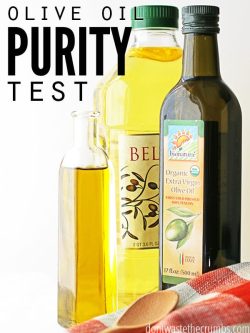
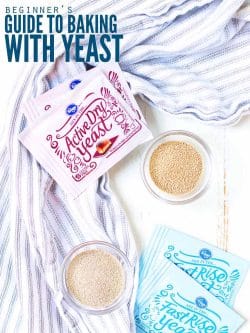
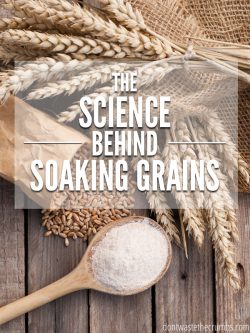
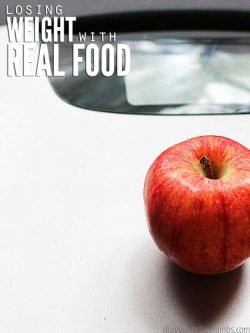

I have just made my second batch of lard for this year and it’s so simple.
Also I know what I’m eating. Thank you
I cook 10 lbs. Of ground beef in my slow cooker at a time. I drain the beef in a mesh colander over a large stainless bowl, then I cover the bowl and place in the fridge. All the beef fat hardens on top. I have been removing the hardened white fat and discarding it. Is this rendered tallow?
It’s definitely the fat from beef Debbie, but it’s not officially tallow since tallow starts from raw fat, and then it’s cooked down.
How can I use what is left after I finish cooking out the tallow? Is there anything else that it can be cooked in or made out of it?
What should I do with the gristle that I strain out? I would hate to waste it!
Can you mix beef fat and pork fat together?
You can Gail, but some people prefer to be separate.
I’m getting half of an organically raised pig soon and they asked if I wanted the fat. Thought I’ll give it a try. Thank you.
thank you so much, i rendered my first lot of beef tonight and its so cool to seethe results
Great article, I love to cook and try different things.
Can the pork and beef lard be combined in the same storage container?
Most likely yes Steve, but they have different tastes and serve different purpose so it would be a bit like combining olive oil and coconut oil together… Lard has a VERY subtle flavor, and is really great in pastries. Tallow would be better suited for foods and frying.
One thing I would add is if it’s yellowing and/or getting brown keep it on the lower heat, all you do is want it to melt it not cook it at all, “if it’s smokes or crackles it’s too hot”. I would say keeping it warm for a few hours or days would work better than getting it super hot and being quicker and different fats work better for different things versus cooking or candlewax
What causes your rendered down lard not to solidify? Can it be reheated to a higher temperature to help it solidify?